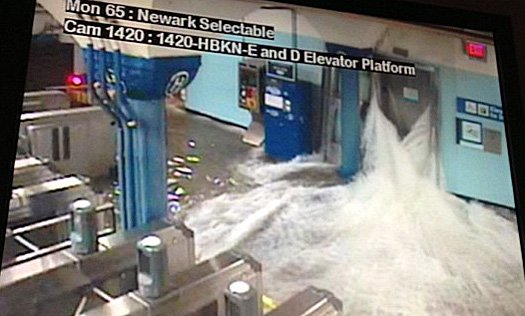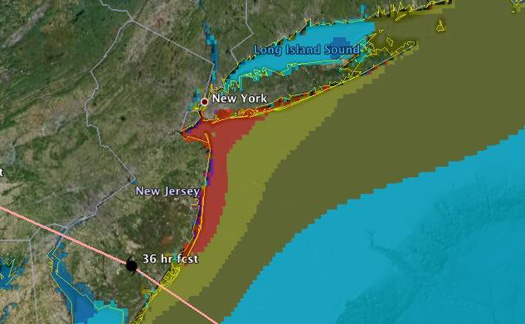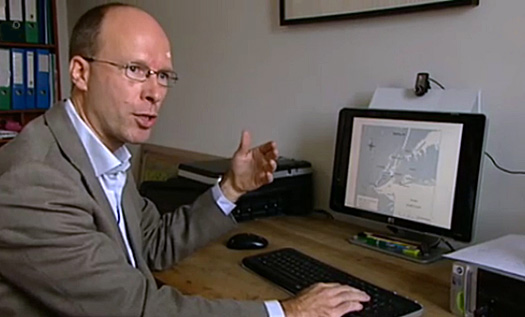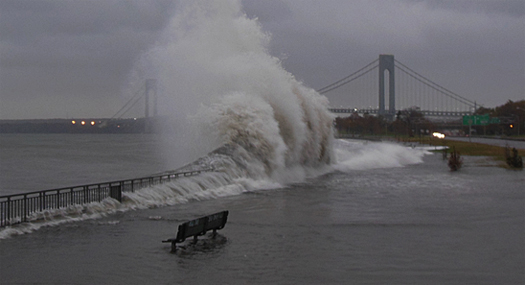Dutch-based flood protection plan for New York to revive in aftermath of superstorm Sandy
"Superstorm Sandy came three months too early", said professor Jeroen Aerts of the Free University of Amsterdam on Dutch television, commenting the 4,5 metre high storm surge that hit New York when the super storm made land fall on October 29th.
Requested by mayor Michael Bloomberg of New York last year after hurricane Irene caused huge economic damage, Aerts is studying all possibilities to protect the city from flooding. One of the option is a Dutch based 'delta plan' with levees and navigable storm surge barriers.
The study is expected to be ready early next year.
The superstorm Sandy killed at least 50 people, many hit by falling trees. Some 375.000 people were evacuated and over 8 million people were without electricity. The damage is estimated to top 20 billion US dollar.
The coastline of New Jersey was the hardest hit area with flooded coastal towns as Atlantic City and Ocean City. In New York the 14 ft storm surge knock out unprotected underground infrastructure as the subway and many power stations.

New York called the flooding of the subway the 'worst devastation' the city’s transit system has ever seen in its 108 year history.
 '
'
Superstorm Sandy caused sea level to rise up to 14 feet along Low Manhattan, New York.
Reluctant to costly engineering options
Six years ago, the New York authorities approached Amsterdam-based scientist Jeroen Aerts for advice. At that time Aerts was involved in a comprehensive study on the vulnerability of coastal cities. New York ranked high as a flood prone city.
"Initially they proved a little bit reluctant in terms of considering large scale protection measures, like surge barriers", according to Aerts.
The Dutch 'delta plan' is a called after the south east river delta area in the Netherlands. This delta area flooded in 1953 and in response to that disaster the national government drew up the 'delta plan' to prevent .
A large scale flood defence system was designed, called the Delta Works. This system includes the two large mobile storm surge barriers, Maeslantkering and Oosterscheldedam.
"These large engineering solutions are expensive, and New York wanted inexpensive solutions", Aerts says. "But this changed last year, after Hurricane Irene caused huge economic damage. Then they also saw this sense of urgency that maybe we should also look at other options", he says.
Aftermath of superstorm Sandy
In the aftermath of superstorm Sandy, Aerts expects the discussion on a large Dutch-based 'Delta plan' to revive. Flood protection in the US is based on building regulations, evacuation and insurance. This has a cultural background as Americans put little confidence in their government and want to take their own responsibility.
"But the economic damage is enormous, especially if a city like New York comes to a halt for a few days", making Aerts doubt on the cost effectiveness of flood risk reduction in the US.

Jeroen Aerts, professor Free University of Amsterdam
Investment in New Orleans already paid back
Expert on global water management Piet Dircke of engineering firm Arcadis reacted in the Dutch media as well. He wonders if the New York authorities will now reconsider their policy .
Dircke mentioned the 14,5 billion dollar reconstruction works on the flood defence system of New Orleans. "In August the levees and barriers withstood the storm surge caused by hurricane Isaac. If the New Orlerans had not improved its flood defence system it would have flooded again. The investment already paid back," according to Dircke.
Conceptual design of storm surge barrier
"In 2009 we have presented New York a conceptual design of a navigable storm surge barrier in the Verrazano Narrows between Long Island and Staten Island. Clearly the time was not right", ascertains Dircke. He hopes superstorm Sandy will lead to a renewed interest from the New York authorities.
"Our design is what a storm surge barrier in the Verrazano might look like”, the global water expert Dircke of Arcadis continues, “as part of an integrated flood protection plan for the Hudson Bay. Such a plan should consist of more elements then a barrier alone. In the Netherlands we are preparing a second 'delta plan' that includes different measures, bot structural and non-structural, for variable scenarios such as climate change and socioeconomic development. These potential measures are compared and combined into a system, were all components work together. With a planning, cost estimates, EIA, prioritization, budgeting, funding, institutional and other aspects," explains Dircke.
Other news items on superstorm Sandy on this website:
● Adoption Dutch-based flood protection would require radical change US safety approach, 18 November 2012
● More new New Amsterdam: innovative flood protection for New York after superstorm Sandy, November 18, 2012
● NRP live radio debate: barricading New York against a rising sea, November 9, 2012
● Aftermath superstorm Sandy: How to reduce flood risk on US and Dutch barrier islands? - November 7, 2012
● Flood experts discuss need for storm surge barriers for coastal cities in aftermath of superstorm Sandy - November 2, 2012
● Netherlands, US intensify cooperation on water management, climate resilience and flood preparedness, 5 March 2013
More information
Free University of Amsterdam/Institute for Environmental Studies
Amsterdam, the Netherlands
+31 20 598 95 28
www.ivm.vu.nl/en
Arcadis
Amsterdam, the Netherlands
+31 20 2011 011
www.arcadis.com





